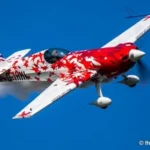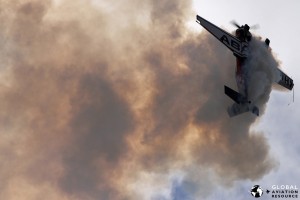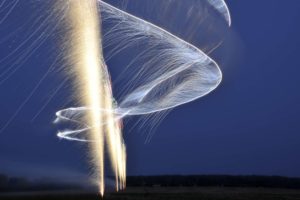Join the circus!
Life with the Global Stars combines C21st barnstorming with the spirit of a travelling circus as the British aerobatic team takes its displays to new airshow audiences around the world
Dubai, Australia, Korea, South Africa, New Zealand: Mark Jefferies’ airshow CV reads like the labels on a well-travelled steamer trunk. Now the nine-times British aerobatic champion is bringing his display team, the Global Stars, and its combination of formation and solo aerobatics to new audiences around the world: last year in Zuhai, China, they added extra octane to the launch of Skoda’s Octavia, before shipping their Extra 300 aircraft by sea to Hyderabad and the India Aviation expo’. Behind each of its 15-minute shows, however, is a story of days of hard work and practice as, like a travelling circus raising its Big Top, the team assembles its aeroplanes and rehearses the display. For all the drama of its climax, however, it’s a story that often begins quietly…
Day 1: The circus arrives
You don’t expect a flying circus to arrive on a scheduled flight, so no-one notices the Global Stars land in Ahmedabad for the Gujarat Aero Conclave 2015. Outside the airport, the pilots – Mark Jefferies, Steve Carver, and Chris Burkett – might pass for English tourists as they study the glare of a dust-laden sky which promises difficult flying conditions. The team’s fourth pilot and larger-than-life display leader, Tom Cassells, has concerns of his own: he’s making a five-day solo flight from the UK to India with his aeroplane. This morning he left Saudi Arabia amid thunderstorms; hopefully, by nightfall he’ll be in Oman.
Day 2: Setting up ‘shop
It takes Tom six hours to fly from Muscat to Ahmedabad – six hours that we spend waiting for airport passes. It’s late afternoon before we’re allowed airside where the aircraft have been brought from the port in Mumbai. It’s 42°C on the apron, and even hotter in the shipping containers as we unstrap the aircraft wings and fuselages, and move them to the workshop – a hangar where our troupe works into the evening setting up makeshift benches and laying out tools. The sun’s long gone before we’ve finished, but with three aircraft to build before the first practice on Sunday time is against us. Tom’s arrival, though, means that the team is now complete, and dinner’s a noisily cheerful affair.
Day 3: Sweat & spanners
Despite our hosts’ offers of assistance, the team must be self-sufficient when it comes to rigging and repairing the aircraft: each pilot works on his own machine; Nick Peel, the team’s engineer, carries out the necessary engineering checks; and Keith Taylor – the sixth Global Star – lends his mechanical skills wherever they’re needed. In this heat, working in the confined spaces becomes a test of patience, and if the task isn’t awkward, it’s both heavy and awkward: the Extras’ 90kg wings have to be lifted and carefully slotted into the fuselages, where they’re secured by pins driven through the carbon-fibre spars with a combination of force and finesse.
Tom, meanwhile, is unbearably cheerful because his aeroplane is already in one piece, or nearly so: the tailwheel of the French-built CAP 232 was damaged during the flight to India. An old soldier, Tom effects a ‘battle-damage repair’, but he’s depending on a replacement being sent from the UK for the flight home.
Eight o’clock: mosquitos are being drawn to the hangar lights, but the aircraft are nearly assembled.
Day 4: Testing the air
“I still can’t believe I’m here,” says Tom as we wait in air traffic control to file a flight plan for the morning’s practice. There probably aren’t many pilots of small, single-seat aircraft who’d cross seas, deserts, and skirt the edges of restless territories where shoulder launched rockets are a published hazard below 20,000ft in order to lead a display; it’s the stuff that pioneering adventures were made of in the 1920s and ‘30s.
As the first practice unfolds over the airport, everyone comes out to watch: perhaps, in their eyes, the team is now transformed from eccentric Brits in badly fitting shorts into real pilots? As someone in the control tower remarks, however, the enthusiasm for aviation in India is such that if we put on a show at three o’clock in the morning, it’d still attract a crowd. In the afternoon, play is interrupted as the heat whips up a dust storm.
Day 5: …Or is it day six?
Twice a day, the team practices at the display site, centred between two bridges over the Sabamarti river. They aren’t rehearsing their routine so much as fitting it to the conditions and the site. The high temperature exacerbates the performance differences between the aircraft, making the co-ordination of formation manoeuvres in the bumpy, thermic air even more challenging. As the display swoops from 2500ft down to around 100ft, the tall buildings and bristling aerials bordering the river become hazards, and in the hazy light, spotting on-coming aircraft in the high-speed cross-overs is difficult. The team has to be able to fly the routine using just 70% of their mental capacity, leaving the rest free to deal with unexpected problems – problems like the birds. The black kites seem curious about the aircraft, flocking towards them in increasing numbers during the display. For the wingmen, concentrating on the leader, they’re only briefly glimpsed, but to the leader himself, the kites – large enough to cause catastrophic damage – look like anti-aircraft fire.
Day 8: VIPs, dreams & daredevils
“When you begin learning to fly,” says Mrs Anandiben Patel, Gujarat’s Chief Minister, comparing flight to aspirations as she addresses the schoolchildren invited to the first display, “you ask yourself if it’s even possible. But with work and perseverance you can realise your dreams.” It’s not dreamers that the local press calls the Global Stars, though, but ‘daredevils’, and when the pilots attend the conclave dinner after the show, one delegate – Sunil – asks a curious question. The display is indeed daring, he agrees, so is there anything more than the pilots’ flying skills keeping the Devil away? Does the divine form part of their back-up plan? It’s a sincere inquiry, but the team’s surprise highlights the cultural frontiers it crosses in its travels; science so often overshadows religion in the West that it’s easy to forget how faith can inform outlooks in India.
Day 10: Good Friday; great display
Every vantage point around the display site is packed with the holiday crowds; traffic across the Ghandi and Nehru bridges comes to a standstill despite the efforts of the police. On climb-out from the airport, the pilots test their smoke systems, leaving short smoke trails that telegraph their impending arrival to the spectators. An enormous cheer goes up, and almost before it dies away, the display breaks above the crowd. For 15 minutes all eyes are on the smoke trails stitching the team’s signature across the sky as the avian loops and rolls of formation flight give way to the tumbling, gyroscopic figures of Tom’s solo aerobatic sequence. To the pilots in their cockpits, the enthusiasm of its audience’s welcome is made clearly visible by its size; India is revealing itself as a whole new airshow world waiting to be explored.
Day 11: The end’s in sight
After this morning’s display, Ahmedabad’s mayor, Meenaxiben Patel visited the airport to present gifts to the team, catching Mark in a grubby polo shirt instead of clean blue overalls. Display flying is often an unglamorous game, and a tiring one, too: fatigue, the heat in the cockpits, and the inevitable illnesses of travel take their toll, and with them comes a prickling sense of being just one step ahead of the dangers. “Right,” Tom laughs, as the team walks out for the final display, “let’s have one more go at losing a canopy to the birds.” Sunil might’ve called it tempting fate, but perhaps this dark humour is a talisman against trouble: half an hour later, the formation emerges unscathed from the haze over the city. Within minutes of shutting down, the aircraft are in the hangar and the process of disassembly has begun. The circus is folding its tents; by this time tomorrow they’ll be nothing to show that they were here save half-a-dozen drums of fuel awaiting the team’s return in 2017.
Day 15: On the road again
With the aircraft en route to the port, and Tom (with a tailwheel borrowed from an Extra; the replacement never arrived) already past the long leg from Saudi to Cyprus and well on his way home, what’s left of the team – having enjoyed one day’s R&R – leaves town on an early flight. Ahead lies the UK display season, after which the Global Stars go on the road again, first to China, then Bahrain, and back to India. It isn’t an easy way to earn a living – and a living is all it earns – but Mark simply shrugs: “You get to travel, to do things that others haven’t; it’s fun.”
One team; four characters
Though they fly together under the Global Stars’ colours, the team is made up of four very individual characters, each of whom arrived on the international display stage by different routes. Over 35 years, Mark Jefferies has clocked up around 3700 hours and a wide range of flying, from being a stunt pilot in movies, and four years as a member of the Aerostars, to a formidable record in competitions.
In those competitions, Tom Cassells – who, after serving in the Royal Armoured Corps, traded tanks for a career in the haulage industry – was often his rival. Having come into flying in 1983, Tom has logged around 7000 hours, and aerobatic competition victories in the UK and abroad. To look at the recent history of the British unlimited aerobatics championship, though, when Mark and Tom passed the trophy back and to between them, you might be surprised to find them in the same team. However, while Mark is Global Stars’ owner, Tom flies as its leader – the ringmaster, if you like – and together the pair make perfect foils for one another, each bringing different qualities of leadership and organisation to the team.
Steve Carver and Chris Burkett, meanwhile, both owe their first aerobatic experiences to de Havilland’s Chipmunk, but while Steve’s early flying was done in gliders before he became first a private and then a commercial pilot, Chris served a barnstorming apprenticeship with Captain Neville’s Flying Circus (true!), and then campaigned a Pitts Special in aerobatic competition, becoming 2006 UK champion in the standard category.







 WhatsApp me
WhatsApp me